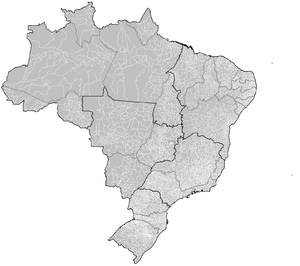Subdivisions of Brazil

Brazil divided into regions, states, and municipalities
Brazil is divided into several types and levels of administrative subdivisions.
Regions
Main article: Regions of Brazil
Since 1942, the Brazilian Institute of Geography and Statistics has divided Brazil into five administrative regions.[1] On 23 November 1970, the regions of Brazil were adjusted slightly to the definition that is still in use today.[2]
- North Region (Região Norte)
- Northeast Region (Região Nordeste)
- Central-West Region (Região Centro-Oeste)
- Southeast Region (Região Sudeste)
- South Region (Região Sul)
States
Main article: States of Brazil
Brazil is divided into 27 federative units: the Federal District, Distrito Federal (DF), and 26 states:
|
|
Municipalities
Main article: Municipalities of Brazil
There are over 5500 municipalities in Brazil. The Federal District is divided into 31 administrative regions.
Statistical Areas
See also: Mesoregions of Brazil and Microregions of Brazil
For statistical purposes, Brazilian municipalities are grouped together into mesoregions and microregions.
See also
- ISO 3166-2:BR
- Proposed states and territories of Brazil
- Former subdivisions of Brazil
References
- ↑ "Divisão Regional". ibge.gov.br (in Portuguese). Instituto Brasileiro de Geografia e Estatística. Retrieved 15 November 2015.
- ↑ Contel, Fabio Betioli. "As divisões regionais do IBGE no século XX (1942, 1970 e 1990)". terrabrasilis.revues.org (in Portuguese). Terra Brasilis: Revista da Rede Brasileira de História da Geografia e Geografia Histórica. doi:10.4000/terrabrasilis.990. Retrieved 15 November 2015.
This article is issued from Wikipedia - version of the 11/18/2015. The text is available under the Creative Commons Attribution/Share Alike but additional terms may apply for the media files.
.svg.png)